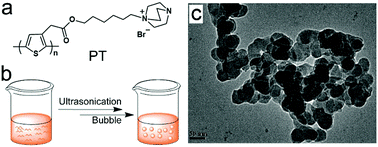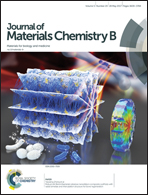Lysosome-targetable polythiophene nanoparticles for two-photon excitation photodynamic therapy and deep tissue imaging†
Abstract
Two-photon excitation (TPE) photodynamic therapy (PDT) has attracted great interest due to its distinctive properties, e.g., good penetration ability of biological tissues and less damage to healthy tissues. However, the conventional photosensitizers (PSs) for PDT have poor subcellular location capability and low two-photon absorption (TPA) cross section in the phototherapeutic window. Herein, we report a fascinating multi-functional TPE PS, polythiophene nanoparticles (PT NPs), for simultaneous lysosome-targetable fluorescence imaging and PDT. PT NPs show bright yellow fluorescence, good water solubility as well as excellent photo- and pH-stability. Moreover, PT NPs exhibit high singlet oxygen generation quantum yield (∼42%) and large TPA cross section (∼3420 GM). A fluorescence imaging penetration depth of 1800 μm could be reached in the tissue phantom under the TPE mode. Due to these outstanding merits and their unique clathrin- and caveola-independent intracellular uptake pathway, PT NPs have great potential for application in TPE fluorescence imaging and photodynamic therapy.



 Please wait while we load your content...
Please wait while we load your content...